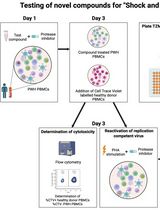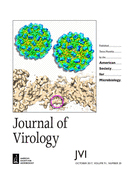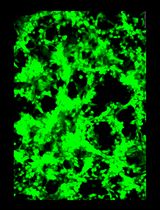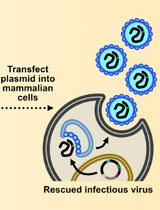- EN - English
- CN - 中文
Liposome Flotation Assay for Studying Interactions Between Rubella Virus Particles and Lipid Membranes
用于风疹病毒颗粒和脂膜相互作用研究的脂质体浮选分析法
发布: 2018年08月20日第8卷第16期 DOI: 10.21769/BioProtoc.2983 浏览次数: 9785
评审: Vamseedhar RayaproluBalasubramanian VenkatakrishnanShweta Kailasan

相关实验方案

诱导型HIV-1库削减检测(HIVRRA):用于评估外周血单个核细胞中HIV-1潜伏库清除策略毒性与效力的快速敏感方法
Jade Jansen [...] Neeltje A. Kootstra
2025年07月20日 2271 阅读
Abstract
Rubella virus (RuV) is an enveloped, positive-sense single-stranded RNA virus that is pathogenic to humans. RuV binds to the target cell via the viral envelope protein E1, but the specific receptor molecules on the target cell are yet to be fully elucidated. Here, we describe a protocol for liposome flotation assay to study direct interactions between RuV particles and lipid membranes in a qualitative manner. Interactions are examined by a Nycodenz density gradient fractionation using UV-inactivated RuV particles and fluorescent-labeled liposomes consisting of pure lipids. Fractionated RuV particles are detected using standard sodium dodecyl sulfate-polyacrylamide gel electrophoresis (SDS-PAGE) followed by Western blot analysis for viral proteins. On the Nycodenz gradient, RuV particles bound to liposomes shift to lower density fractions than unbound RuV particles. Using this protocol, we provide compelling evidence that, at neutral pH in a calcium-dependent manner, RuV particles bind to lipid membranes containing both sphingomyelin (SM) and cholesterol in certain cell types.
Keywords: Liposome flotation assay (脂质体浮选分析法)Background
Rubella virus is the causative agent of ‘rubella’, an acute and relatively mild systemic infection and ‘congenital rubella syndrome’, a trans-placental fetal infection leading to serious birth defects (Hobman, 2013). Elucidation of molecular mechanisms of RuV entry is essential for understanding viral pathology and helpful for developing anti-RuV drugs. Though previous studies have suggested that membrane lipids of host cells serve as RuV receptors (Mastromarino et al., 1989 and 1990; DuBois et al., 2013), the detailed mechanism remains unknown. Recently, we found that RuV binds to erythrocytes and lymphoid cells in a calcium-dependent manner, and that the calcium-dependent viral binding is impaired after treatment of these cells with sphingomyelinase or cholesterol-adsorbent methyl-β-cyclodextrin, suggesting that SM and cholesterol of the host plasma membrane are critical for binding (Otsuki et al., 2018). To obtain compelling biochemical evidence, we established an assay system to detect interactions between RuV particles and lipids.
Representative biochemical assays widely applied for studying interactions between proteins and lipids are liposome co-sedimentation and co-flotation assays (Zhao and Lappalainen, 2012). Provided that RuV particles and liposomes form aggregates pelleted by low-speed centrifugation in analogy with viral hemagglutination, we initially tried to apply liposome co-sedimentation assay. Unfortunately, our trial of the co-sedimentation assay showed that only a small amount of RuV particles was pelleted at 15,000 x g in the presence of any liposomes. Nevertheless, RuV particles tended to be less pelleted in the presence of liposomes containing both SM and cholesterol, compared with those containing either or neither of the two lipids, providing us with direction for the study. Following this, we devised a flotation assay that can be performed on a small scale. For this, we employed a protocol originally applied for characterization of phosphoinositide binding of the S. cerevisiae Hsv2 (homologous with swollen vacuole phenotype 2) protein (Busse et al., 2013). After making several modifications in the original protocol to optimize for RuV analysis, we have established the protocol described below. By analysis with this protocol, we revealed that both SM and cholesterol are responsible for the calcium-dependent membrane binding of RuV particles.
Materials and Reagents
- Round-bottom glass tubes (size: 16 x 100 mm) (AGC Techno Glass, IWAKI, catalog number: TST-SCR16-100 ) with screw caps (AGC Techno Glass, IWAKI, catalog number: 9998CAP415-15 )
- Round-bottom glass tubes (size: 12 x 75 mm) (AGC Techno Glass, IWAKI, catalog number: 9831-1207 )
- Polypropylene centrifuge tubes:
15 ml (AS ONE, VIOLAMO, catalog number: 1-3500-21 )
50 ml (Corning, Centristar, catalog number: 430829 ) - Polypropylene microfuge tubes:
1.5 ml (FUKAE KASEI, Watson, catalog number: 131-415C )
1.5 ml (Safe-Lock tubes, Eppendorf, catalog number: 0030 120.086 , for heating SDS-PAGE samples)
2.0 ml (FUKAE KASEI, Watson, catalog number: 132-620C ) - Polycarbonate ultracentrifuge tubes (Beckman Coulter, catalog number: 343778 )
- Pipette tips (Quality Scientific Plastics):
1-200 μl (Thermo Fisher Scientific, catalog number: 110-96RSNEW )
100-1,000 μl (Thermo Fisher Scientific, catalog number: 111-NXL-R100S ) - Serological pipets (Costar stripette):
5 ml (Corning, catalog number: 4487 )
10 ml (Corning, catalog number: 4488 ) - Immune-Blot polyvinylidene fluoride (PVDF) membrane (Bio-Rad Laboratories, catalog number: 1620177 )
- Chromatography papers (Whatman 3MM Chr, GE Healthcare, catalog number: 3030-672 )
- Polystyrene containers (180 x 90 x 45 mm) (AS ONE, catalog number: 1-4698-09 )
- Black 96-well strip plate (Black Combiplate 8, Labsystems, catalog number: 95029450 )
Note: This product has been discontinued. - Parafilm (Bemis, catalog number: PM996 )
- 1,2-Dioleoyl-sn-glycero-3-phosphocholine (DOPC) (50 mg/ml in chloroform, Avanti Polar Lipids, catalog number: 850375C )
Note: Store at -30 °C. - SM from egg (Avanti Polar Lipids, catalog number: 860061P )
Note: Store at -30 °C. - Cholesterol (Sigma-Aldrich, catalog number: C8667 )
Note: Store at -30 °C. - L-α-Phosphatidylethanolamine-N-(lissamine rhodamine B sulfonyl) (Ammonium Salt) (Rhod PE) (1 mg/ml in chloroform, Avanti Polar Lipids, catalog number: 810146C )
Note: Transfer the solution to a round-bottom glass tube with a screw cap. Seal the cap with parafilm to avoid evaporation. Protect from light and store at -30 °C. Approximate molar concentration calculated with molecular weight of predominant species (1275.678 g/mol): 0.8 mM. - Chloroform (Wako Pure Chemical Industries, catalog number: 038-02601 )
Caution: Chloroform is volatile and hepatotoxic. Thus, when using chloroform and its mixtures, one MUST deal with them in a fume hood or with alternative equipment for chemical safety. - Methanol (Sigma-Aldrich, catalog number: 19-2410-4 )
- Ethanol (Wako Pure Chemical Industries, catalog number: 057-00456 )
- Water (ultrapure water, e.g., Milli Q)
- UV-inactivated RuV particles for hemagglutination inhibition test (RuV antigens) (Denka Seiken, catalog number: 310071 )
Note: Store at -30 °C. After reconstitution with 1 ml/vial of water, store at 4 °C and use within 3 days. - Calcium chloride dihydrate (CaCl2•2H2O) (NACALAI TESQUE, catalog number: 06731-05 )
- Tris-buffered saline (10x, pH 7.4) (TBS) (NACALAI TESQUE, catalog number: 35438-81 )
- Protease inhibitor cocktail for use with mammalian cell and tissue extracts (100x) (NACALAI TESQUE, catalog number: 25955-11 )
- 5-(N-2,3-dihydroxypropylacetamido)-2,4,6-triiodo-N,N’-bis(2,3-dihydroxypropyl) isophthalamide (Nycodenz) (Sigma-Aldrich, catalog number: D2158 )
- Sodium dodecyl sulfate (SDS) (NACALAI TESQUE, catalog number: 02873-75 )
- Glycerol (Wako Pure Chemical Industries, catalog number: 075-00616 )
- Dithiothreitol (DTT) (NACALAI TESQUE, catalog number: 14112-94 )
- Bromophenol blue (Wako Pure Chemical Industries, catalog number: 029-02912 )
- Tris(hydroxymethyl)aminomethane (Tris) (NACALAI TESQUE, catalog number: 35434-21 )
- Glycine (NACALAI TESQUE, catalog number: 17109-64 )
- Hydrochloric acid (HCl) (Wako Pure Chemical Industries, catalog number: 080-01066 )
- 30% (w/v)-Acrylamide/bis mixed solution (37.5:1) (NACALAI TESQUE, catalog number: 06144-05 )
- Ammonium peroxodisulfate (APS) (NACALAI TESQUE, catalog number: 02627-34 )
- N,N,N',N'-Tetramethylethylenediamine (TEMED) (NACALAI TESQUE, catalog number: 33401-72 )
- Prestained protein markers such as PINK prestained protein ladders (NIPPON Genetics, catalog number: MWP02 ) and ExcelBandTM 3-color regular range protein maker (SMOBIO Technology, catalog number: PM2500 )
- Skim milk (BD, Difco, catalog number: 232100 )
- Polyoxyethylene(20) sorbitan monolaurate (Tween 20) (Wako Pure Chemical Industries, catalog number: 167-11515 )
- Goat anti-RuV virion (strain HPV-77) polyclonal antibody (Acris Antibodies, catalog number: BP1061 )
Note: Store at 4 °C. For long time storage, aliquot and store at -30 °C. - Mouse monoclonal anti-goat/sheep IgG–peroxidase antibody (Sigma-Aldrich, catalog number: A9452 )
Note: Store at 4 °C. For long-time storage, aliquot and store at -30 °C. - Immobilon Western Chemiluminescent HRP Substrate (Merck, catalog number: WBKLS0500 )
- Chloroform/methanol (19/1, v/v)
- 0.2 M CaCl2
- 1 M DTT
- 1% (w/v) bromophenol blue in 50% (v/v) ethanol
- 10% (w/v) SDS
- 1 M Tris-HCl pH 8.8
- 1 M Tris-HCl pH 6.7
- 10% (w/v) APS
- 20% (w/v) Tween 20
Note: Store at 4 °C. Check bacterial or fungal contamination before use. - Lipid stock solutions
- TBS (see Recipe 4)
- 2x TBS (see Recipe 5)
- 80% (w/v) Nycodenz/TBS (see Recipe 6)
- 30% (w/v) Nycodenz/TBS (see Recipe 7)
- 3x SDS sample buffer (see Recipe 8)
Note: Aliquot and store at -30 °C. - 10% (w/v) polyacrylamide separating gel solution (see Recipe 9)
- 5% (w/v) polyacrylamide stacking gel solution (see Recipe 10)
- 10x Tris/Glycine (see Recipe 11)
- Electrode buffer (see Recipe 12)
- Transfer buffer (see Recipe 13)
- TBS-T (see Recipe 14)
- 5% (w/v) skim milk/TBS-T (see Recipe 15)
- 2% (w/v) skim milk/TBS-T (see Recipe 16)
Equipment
- Micropipettes durable against organic solvent dispensing (NICHIRYO, model: Nichipet EX Plus II, catalog numbers: 00-NPLO2-20 , 00-NPLO2-200 , 00-NPLO2-1000 )
- Pipet-Aid XP Pipette Controller (Drummond Scientific, catalog number: 4-040-101-J )
- Vortex mixer (Delta mixer, TAITEC, model: Se-08 )
- Nitrogen evaporator with water bath (Nakajima seisakusho, Co., Ltd., custom-made)
- Fume hood equipped with activated charcoal filters (Dalton, model: DC-183-100 )
- Probe-type ultrasonic processor (Hielscher Ultrasonics, model: UP50H )
- Micro refrigerated centrifuge (e.g., KUBOTA, model: 3520 )
- Electronic balance (Shimadzu, LIBROR, model: EB-340HW ; Mettler-Toledo International, model: ML802/52 )
- Ultracentrifuge (Beckman Coulter, model: OptimaTM TLX with TLS-55 rotor)
- Block heater for microfuge tubes (Nippon Genetics, Fast GeneTM, model: FG-02N )
- pH meter (TOA Electronics, model: HM-30S )
- Microwave oven (TOSHIBA, model: ER-225 )
- Protein electrophoresis apparatus for SDS-PAGE (e.g., BIO CRAFT, model: BE-S28 for wide mini gels)
- Western blot apparatus (e.g., Bio-Rad Laboratories, CriterionTM blotter for wide mini gels, catalog number: 1704070 )
- Power supply (ATTO, model: AE-8450 , for SDS-PAGE; Bio-Rad Laboratories, model: 250/2.5 , for Western blotting)
- Tube rotator (SCINICS, model: RVM-101 )
- Reciprocal (TAITEC, model: Personal-11 ) and/or seesaw (TAITEC, model: Wave-SI ) shakers
- Chemiluminescent imaging system (ATTO, model: WSE-6200H LuminoGraph II)
- Microplate reader (BMG LABTECH, model: FLUOstar Optima )
Software
- ImageSaver 6 for Windows (ATTO Co.) as image acquisition software for WSE-6200H LuminoGraph II
- CS Analyzer 4 for Windows (ATTO Co.) as image analysis software
- Microsoft Excel 2016 (Microsoft Corp.) as spreadsheet software
- GraphPad Prism 7 (Graph Pad Software) as graph drawing software
Procedure
文章信息
版权信息
© 2018 The Authors; exclusive licensee Bio-protocol LLC.
如何引用
Saito, K., Otsuki, N., Takeda, M. and Hanada, K. (2018). Liposome Flotation Assay for Studying Interactions Between Rubella Virus Particles and Lipid Membranes. Bio-protocol 8(16): e2983. DOI: 10.21769/BioProtoc.2983.
分类
微生物学 > 微生物-宿主相互作用 > 病毒
生物化学 > 脂质 > 脂质-病毒互作
微生物学 > 微生物-宿主相互作用 > 体外实验模型
您对这篇实验方法有问题吗?
在此处发布您的问题,我们将邀请本文作者来回答。同时,我们会将您的问题发布到Bio-protocol Exchange,以便寻求社区成员的帮助。
提问指南
+ 问题描述
写下详细的问题描述,包括所有有助于他人回答您问题的信息(例如实验过程、条件和相关图像等)。
Share
Bluesky
X
Copy link











